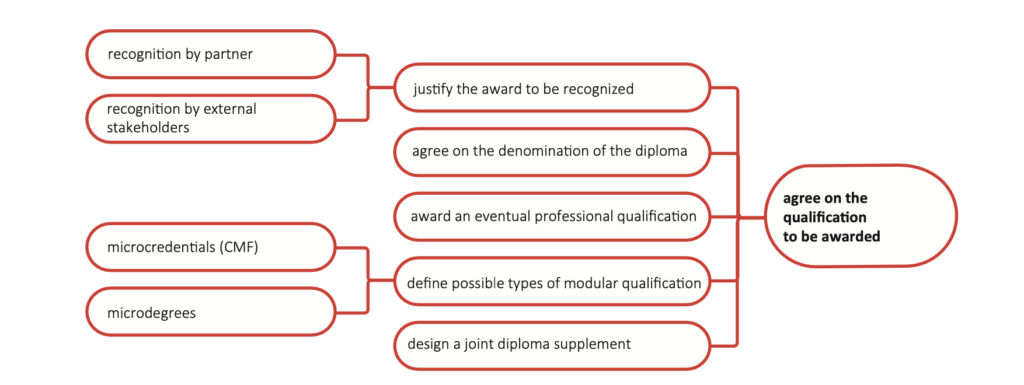
| The partnership has to agree on a qualification for the joint master’s. Successive decisions have to be made: |
| • Justify the master’s degree to be recognized; |
| • Agree on the denomination of the diploma; |
| • Award a professional qualification; |
| • Define possible types of modular qualifications; |
| • Design a diploma supplement. |
Guidelines
Justify the award to be recognized
Indicate why the joint master’s programme should lead to academic recognition by the partner universities and which joint diploma should be awarded. Think of the content, EQF level and size of the programme.
Also seek recognition from outside stakeholders such as professional organizations and employers to enable learners to valorize joint master’s degree for professional development credits or for accreditation by professional bodies (e.g. related to professions in psychology, IT, medicine / healthcare, accountancy, education, sectors).
Agree on the name of the diploma
A joint master’s programme results in a joint master’s degree, signed by all rectors of the universities involved in the partnership. The degree is awarded on a single document according to the rules applied in the leading university. A joint diploma may be bound by national regulations, especially given the language of the diploma. If two universities are involved, in such case a certificate is issued on both sides of the document, signed by both universities.
If, for an important reason, no joint diploma can be awarded, a double or multiple diploma will be issued. In the case of a joint study programme with two universities, this means that the student receives two documents, one from each university. The award of this double or multiple diploma is stated on both diploma supplements.
Normally, a double or multiple qualification is issued in case a learner follows only a substantial mobility window or course package at an individual university (see e-book on curriculum collaboration and mobility). This case is apparently very different from a joint programme that is co-owned by universities in a consortium, for which, as a rule, a joint degree and diploma supplement must be awarded.
Define possible types of modular certification
If the joint master’s is structured in a modular way, certificates can eventually be issued after each consistent module. This is especially relevant when the joint master’s is organized in the context of continuing education and professional development. Students can then individually follow a micro-credential or micro-degree or they can flexibly spread
their master’s studies over a longer period of time. This flexibility is easier to organize when digital teaching and learning methods are used.
In the context of the European Education Area and the European Digital Education Plan, the European Commission has prepared a proposal of Recommendation to the Council of Ministers on Micro-credentials (European Commission, 2021), which is expected to be implemented by Member States by 2024. institutions for a more harmonized approach to qualifications for lifelong learning and professional development. It also encourages modular studies.
In the Common Microcredential Framework (European MOOC Consortium, 2018), a microcredential qualification meets the following requirements, addressing the study time horizon of learners who combine work and study:
• An EQF qualification level of 5 to 8 (;
• A study load of 4 to 6 ECTS or 100 to 150 study hours;
• A reliable and valid assessment;
• Stackable to other programmes.
Current qualifications assigned to for longer modules or micro degrees (20-40 ECTS) are for example: “Undergraduate / Postgraduate Certificate”, “Undergraduate / Postgraduate Module”, “Expert track Certificate” “Specialization in …,” Expert in … “, “Professional Certificate”, “Focus Diploma”.
Some microdegrees contain MOOCs or are fully MOOC-based programmes with qualifications such as “MicroMaster’s” and “Nanodegrees”.
Provide a professional certificate
In some cases, short learning programmes are co-developed or accredited by professional organizations, business sectors or public services. These organizations will recognize and accredit these programmes as an ongoing professional development activity. In some cases, they issue a specific professional certificate in addition to the academic award of the programme consortium. They can also support the programme with funding or grants.
In some countries, students can take advantage of a “personal learning account” when taking such a recognized programme.
Design a joint diploma supplement
A joint master’s diploma is accompanied by a joint diploma supplement with information as described in the ECTS Users’ Guide and Europass. This is important for the valorisation of the certificate in academia and by employers. Descriptors are:
• information identifying the holder of the qualification;
• information identifying the qualification;
• information on the level and duration of the qualification;
• Information about the completed programme and the results achieved;
• Information about the function of the qualification (eg Stackability)
• the certification of the supplement;
• information about the national higher education system;
• Extra information.
In addition, it must contain:
• information on the mobility scheme followed in the joint programme;
• Information about the delivery method.
(see: http://ehea.info/Upload/document/ministerial_declarations/EHEAParis2018_Communique_
AppendixIV_952782.pdf)
next chapter: Create an educational and technological ecosystem
previous chapter: Design the joint curriculum
back to overview: Models and guidelines for the design and development of joint master’s programmes
